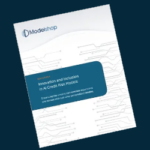The first blog in this series highlights how credit automation is changing the way lenders make credit decisions. In this edition, we’ll dive deeper and outline how automation is now infused throughout the modern credit application process. As a result, credit decision engines are evolving into ‘credit automation engines’ that can impact not only the lending decision, but all aspects of originating high-value loans.
The term ‘frictionless lending’ refers to making it easy and streamlined for borrowers to apply for and obtain loans. This process is important for several reasons:
- Improved customer experience: Frictionless loan origination offers a better customer experience by reducing the time and effort required to apply for a loan. This can lead to increased customer satisfaction and loyalty.
- Increased efficiency: By automating and simplifying the loan origination process, lenders can save time and resources, allowing them to process loan applications more quickly and efficiently.
- Competitive advantage: In a crowded lending marketplace, offering a frictionless loan origination process can be a key differentiator for lenders looking to attract and retain customers.
- Reduced risk: A frictionless loan origination process can help reduce the risk of fraud and errors, as automated systems can detect and flag potential issues more quickly and accurately than manual processes.
Lenders are pursuing frictionless lending as a top priority. According to “The Rise of Frictionless Lending: Trends and Opportunities” by Deloitte, a survey of lenders found that 30% had already implemented frictionless lending processes, and another 27% planned to do so within the next year.
Frictionless lending is more than an improved UX
Millennials and Gen-Z think about financial products differently than Generation X and Baby Boomers. The younger generations grew up with instant access to data, unlimited choices in entertainment and an expectation that products are served up in an easy to consume way. Generations that never opened a map for directions are not prepared for a complicated or opaque loan application. They’re not expecting to wait for an answer, and they’re certainly not used to being rejected.
According to a study by Bank of America, 57% of Gen Zers prioritize a fast and easy loan application process over getting the best interest rate. Additionally, a survey by Experian found that 73% of Gen Zers would prefer to complete a loan application online, rather than in person or over the phone. These findings suggest that traditional loan application processes, which can be lengthy and complicated, may not be effective in attracting younger customers.
57% of Gen Zers prioritize a fast and easy loan application process over getting the best interest rate
Bank of America
Innovative lenders and FinTechs have already raised the bar on the user experience (UX) while applying for credit. Many have also integrated alternative data sources to help reduce risk and deliver an easier application process. These improvements alone will not be enough to remain competitive unless lenders are willing to go further and change the way they analyze risk and make credit decisions.
Using intelligence to reduce application friction
Delivering a frictionless lending experience requires the use of intelligence across the origination lifecycle. Intelligent origination solutions determine what information is required as the application progresses, clarify possible exceptions using intelligent chat, and enable the applicant to adjust loan structures and collateral choices in real-time.
As an example, if a credit report identifies a lien on an applicant’s property while applying for a loan, a typical underwriting process would be to ask the applicant to explain the lien, provide additional documentation and then make an expert decision whether the lien will adversely impact the borrower’s ability to repay the loan. Today, this type of exception handling is manual for most lenders.
In the frictionless origination world, this basic process will remain the same, it will just be instant. Predictive models will estimate the impact the lien will have on the probability of default, and the credit intelligence engine will be adaptive enough to ask for (or electronically retrieve) additional qualifying details that inform the risk model. This has to happen in seconds so that the applicant remains engaged in the process. Once an application enters a wait state, completion and conversion rates can drop precipitously.

There are examples of using data and analytics to streamline the process already in the market today. For example, access to online banking transaction data through providers such as Plaid have enabled lenders to instantly verify an applicant’s income. Advanced analytics, such as time-series analysis and unstructured text classification have enabled income verification algorithms to expand beyond standard payroll patterns and provide instant income estimations for self-employed and gig-economy applicants. Improving the process is not just about alternative data – intelligent decisions require a combination of data and real-time analytics to replicate the intelligence of a human credit analyst in order to deliver a frictionless experience.
Adjusting lending terms in real-time
An advantage in attracting and converting applicants will be presenting the optimal loan configuration as the first or even the only option. This emerging generation of borrowers expect to be shown products that match their needs by retailers and streaming services. They will expect the same from lenders. The era of sitting in the finance office at a car dealership while the finance officer picks through a list of potential programs is ending.
Next generation lending models will be intelligent enough to predict the most likely loan structure (lowest payments vs. lowest lifetime cost vs. flexible payments) and can create a custom loan offer that maximizes the fit for the applicant, instantly. More educated borrowers will want to know their financing options before they walk into a dealership or put an offer on a home, and they’ll demand the ability to restructure the loan on the fly if their purchase decisions change.
This means two things from a technology perspective. First, predictive analytics, including both risk and propensity predictors, need to be built directly into decision and pricing models instead of being developed as offline static risk tables. Second, decision models will no longer be able to decision a single loan configuration.
The time where 100% straight-through application processing is a competitive minimum requirement is rapidly approaching.
Instead, they will need to explore a spectrum of options, typically in multiple dimensions, to find the best ‘cost function’ value. For example, loan pricing may be determined by projected lifetime value of the loan informed by default and churn predictors. The loan structure that is the most likely to be accepted while maximizing the profit to the lender and creating a satisfied customer is the loan that should be presented. To add to the complexity, that best solution may change on the fly as the borrower explores different purchase options, for example upgrades during a vehicle purchase.
This ‘nonlinear solver’ technology is not new, it has been used extensively in operations research applications such as figuring out how to best pack your Amazon package in a UPS truck, but it is relatively new to the lending arena. More importantly, the entire lending technology stack will need to evolve to support optimized product configurations, decisions and pricing in real-time in order for lenders to remain competitive.
Coming up next…
In my next post I will discuss the impact embedded financing and alternate lending products such as Buy Now Pay Later are having on credit intelligence engines.







